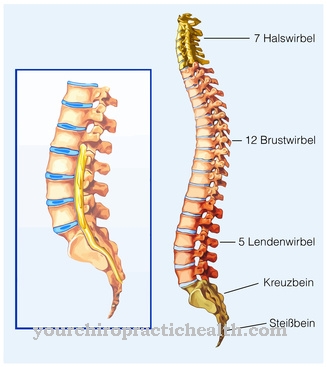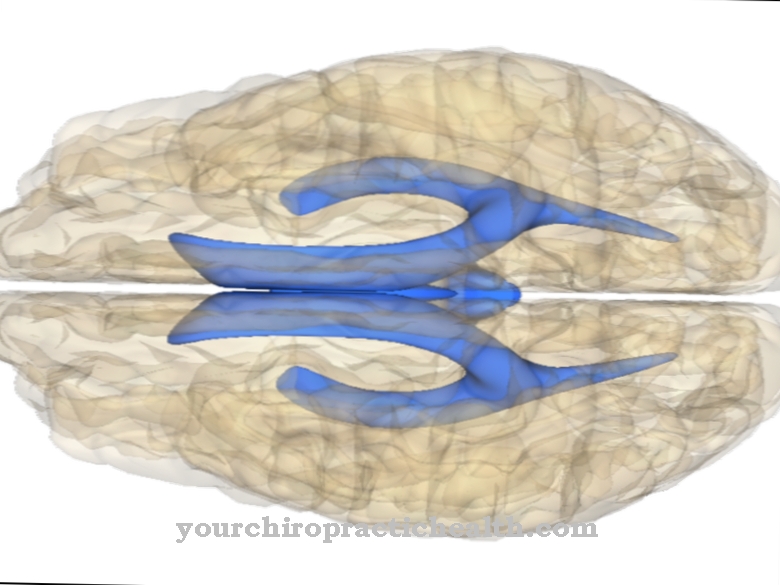Of the Tensor veli palatini muscle is part of the pharyngeal muscles of humans. He takes on an important function in the act of swallowing. Its job is to prevent food or liquids from entering the windpipe when swallowing.
What is the tensor veli palatini muscle?
The tensor veli palatini muscle belongs to the muscles in the palate of the human being.It is considered part of the skeletal muscles of the head. The tensor veli palatini muscle is located in the throat or throat. Its task is to stretch the soft palate during the swallowing process.
This creates an important prerequisite for a symptom-free swallowing process. He ensures that the food and liquids ingested are transported directly into the esophagus. When the tensor veli palatini muscle contracts, the soft palate tenses. This then sits like a closure in front of the nasal cavity. The tensor veli palatini muscle also helps to equalize pressure in the ear. This is necessary to pass on the recorded sound waves and to enable hearing.
Anatomy & structure
The fibers of the IX. and the Xth cranial nerve jointly innervate parts of the pharyngeal muscles via the pharyngeal plexus. There they supply the levator veli platini muscle. This person is jointly responsible for lifting the soft palate.
Lateral opposite the levator veli platini muscle is the tensor veli palatini muscle. This is innervated by a branch of the mandibular nerve. The fine nerve branch is known as the Ramus musculi tensoris veli palatini. The mandibular nerve is a terminal branch of the trigeminal nerve. This is the 5th cranial nerve. The tensor veli palatini muscle is a wide and thin muscle. Its course looks like that of a loop. The tensor veli palatini muscle has its origin in the sphenoid bone.
Its course begins there between the wing of the sphenoid bone, the angular spine and a depression in the sphenoid bone, the sphenoid bone. It continues to pull on the lateral side of the elastic occlusive cartilage of the auditory tube. The muscle is deflected by the small bone process of the sphenoid bone. This has the shape of a hook. The tensor veli palatini muscle reaches the flat structure of the connective tissue. This is the palatal aponeurosis or palatine aponeurosis. This is where the soft palate is located, which is also known as the palatum molle and which spans the soft palate, the velum palattinum.
Function & tasks
The tensor veli palatini muscle has two functions. Its main task is to stretch the soft palate. This ensures that the soft palate functions properly during the act of swallowing. The soft palate stretches towards the back of the mouth. It becomes visible when the mouth is opened wide. There is a double fold with a suppository there. The uvula is in the middle and hangs down vertically.
It is soft and freely movable. The region around the uvula is just as soft in a relaxed state. This area becomes tense during the swallowing process. Because this process is similar to the process in sailing, which occurs when the wind presses into the sail, the region of the soft palate is called the soft palate. Tensioning the sail causes it to tighten like a closure to the nasal cavity.
This allows food, liquids and saliva to flow directly into the esophagus. This process prevents everything else apart from air from staying away from the windpipe. In addition, the tensor veli palatini muscle is an important element so that pressure can be equalized in the ear. It causes the ear trumpet to open so that air can escape between the outside world and the middle ear. This is a necessary process so that the sound waves picked up by the so-called pinna, the outer ear, can be transported further and enable hearing.
You can find your medication here
➔ Medicines against coughs and coldsDiseases
Daily complaints in the palate area can result from the intake of hot food and drinks. These cause a pain sensation on the tongue up to the roof of the mouth. The mucous membranes in the entire mouth and throat area are attacked.
The most common diseases that affect the palate include infection and inflammation. They include colds, flu, or angina. These lead to defects in the mucous membranes and cause problems during the act of chewing and swallowing. Similar complaints arise when a fungus forms in the roof of the mouth, in the throat, on the tongue or on the lips. Tooth problems or inflammation of the roots of the teeth can also impair the swallowing process. In addition, allergic reactions or inflammation of the nerves can cause irritability and pain in the entire throat. A tumor in the mouth or throat can lead to the ingestion of food no longer being symptom-free.
Cleft lip and palate disease is a congenital malformation. A symptom of this condition is the splitting of the soft palate. This has an adverse effect on the swallowing process. In a newborn, the malformation is corrected in the first few weeks of life by an operation.
As soon as the tensor veli palatini muscle is restricted in its functional activity, this affects the functionality of the levator veli palatini muscle. This means that there are abnormalities in language formation. Certain sounds, such as the letter "r" or the letter combination "ch", can no longer be pronounced correctly. There are also effects on sound production when the mucous membranes in the mouth and throat area are no longer fully functional.






.jpg)

















.jpg)



